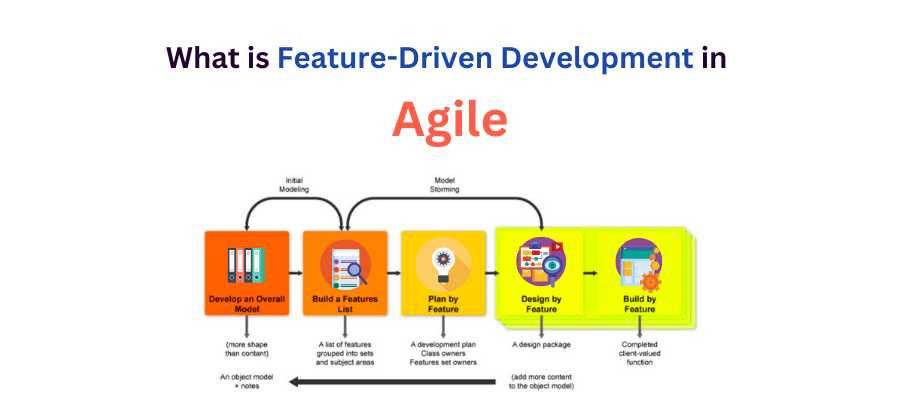What is Feature-Driven Development in Agile

Feature-Driven Development (FDD) is one of several Agile frameworks. Although it is less popular than others like Scrum or Kanban, it is still beneficial and has its rightful place in the development of products like software.
Also, FDD works better than many other Agile frameworks when dealing with large projects that last a long time, which is often the case for many organizations dealing with software development.
Any organization seeking to implement FDD needs to understand the process it entails and also the potential benefits the framework can generate.
Overview of the FDD Framework
FDD is an Agile framework built around the development of features that satisfy the needs of customers or clients. The framework focuses on giving the clients regular and on-time delivery for maximum satisfaction.
Implementing an FDD framework first requires the creation of a Domain Object Model. All the features and groups of features are then identified and prioritized. The implementation then proceeds incrementally.
Smaller increments make management easier, but the tasks are further divided into Agile iterations. With the Agile iterations, the product developers have to repeat several steps until the deliverables are good enough for the final release.
Like with most other Agile frameworks, the FDD team has to do regular inspections and prepare progress reports for different stages. All this ensures the team and process maintain high-quality standards.
There are 6 main FDD team roles:
- Project Manager
- Development Manager
- Chief Architect
- Chief Programmer
- Domain Expert
- Class Owner
Benefits of FDD
1. Clear and Easier Project Management
The overall system in FDD will be built progressively, unlike in other Agile frameworks, by developing each feature individually before merging them. This way, the team will only have to focus on one feature at a time. And so, management becomes clearer and easier than managing the entire system at once.
2. Delivers Better Quality Products
The iterative nature of FDD makes it possible for the team to showcase the product to peers or the client during all stages of development. There is hence more transparency in the process, and the team also gets feedback they can use to improve the product or process to ensure the final deliverable is the best quality.
3. Simplified Process Tracking
FDD divides the project into several features, making it easy to track the progress of each individually. This helps reduce the risks associated with the release of a new feature. For instance, when developing software, the FDD framework makes it easy to track bugs and fix them before delivering new features, which reduces the risk.
4. Allows for More Rapid Development
The FDD framework is broken down into 5 steps. These steps simplify the implementation process and will allow for rapid product development. Everyone understands their roles in the process and what needs to be done at each step, so there is no time wastage. Also, FDD will leverage already pre-defined standards, allowing teams to move even faster.
The FDD Framework Process – The 5 Key Stages
1. Overall Model Development
At the first stage, the team focuses on defining and shaping the project’s overall scope. The key things here are determining the target audience, identifying the problems that need solving, and coming up with the general context of the project.
2. Building a Features List
Next step is to is identifying the required features. The team does this by using the overall model developed in the first stage. It is essential to consider all the development activities necessary for the successful development of the product. Also, the Project Manager should make the features description as detailed as possible, given that FDD teams are large and rarely communicate directly.
3. Planning Phase – Plan by Feature
The planning phase entails breaking down the identified features into specific tasks. Time and resource estimates for each feature are done at this stage. Deadlines for each feature are set in the planning phase. It is crucial to have all team members participate when planning as their input provides more accurate estimates, and it is also a way of ensuring everyone feels part of the process.
4. Designing Phase – Design by Feature
The design phase is where the actual work begins. Here the team works collaboratively to design the features to be developed under the supervision of the Project Manager. The Project Manager directs the team on what to prioritize and also assigns specific tasks to each member.
5. Building Phase – Build by Feature
At the last stage, each team will work to convert their design into the final product. They also have to test it and get feedback to ensure everything is working as intended. The feature is then sent to quality assurance for further testing. If it is okay, it is integrated with previous iterations, and the team can tackle the next feature.
Conclusion
FDD is an iterative Agile framework best suited for large and complex projects that take a long time to implement. It breaks down the process into 5 easy steps to simplify things and ensure more rapid implementation.
Also, the FDD framework makes it easier to track progress and ensures the delivery of better-quality products, as the team can get feedback from stakeholders at all stages of development.
The customer/client-centered nature of FDD also makes it an ideal framework for any organization looking to ensure maximum customer satisfaction. And this is also one of the best Agile methods for any team looking for something structured and easily scalable with more predictable outcomes.
References
- https://www.digite.com/agile/feature-driven-development-fdd/
- https://userpilot.com/blog/feature-driven-development/
- https://airfocus.com/glossary/what-is-feature-driven-development/



